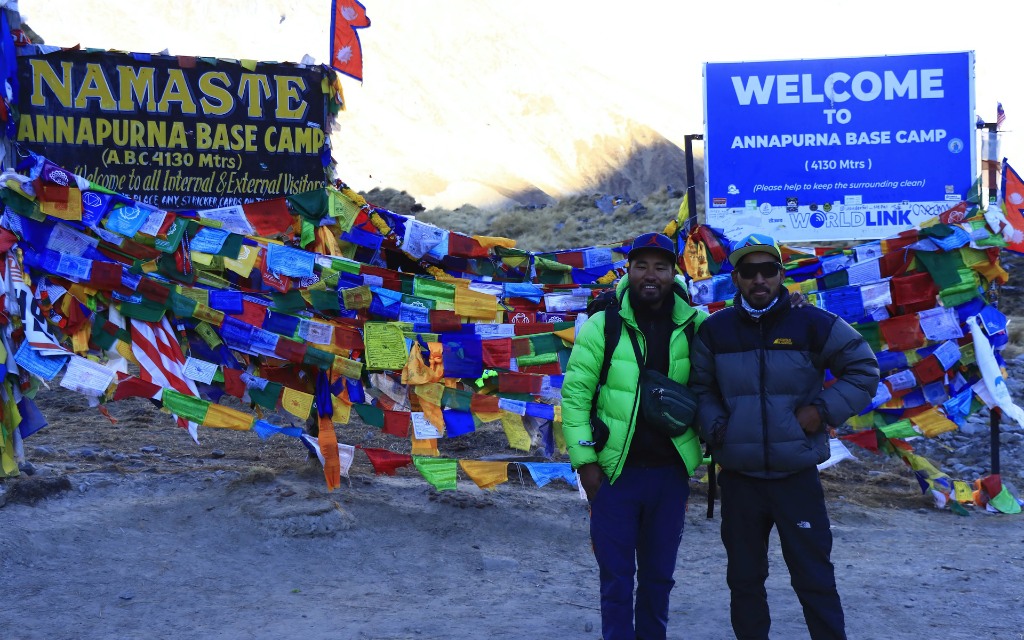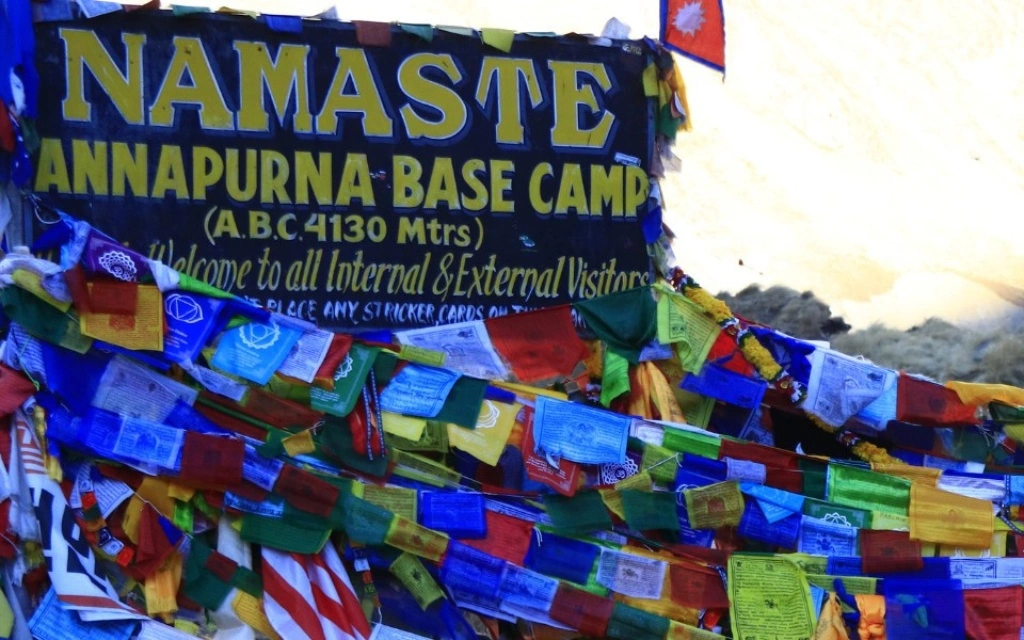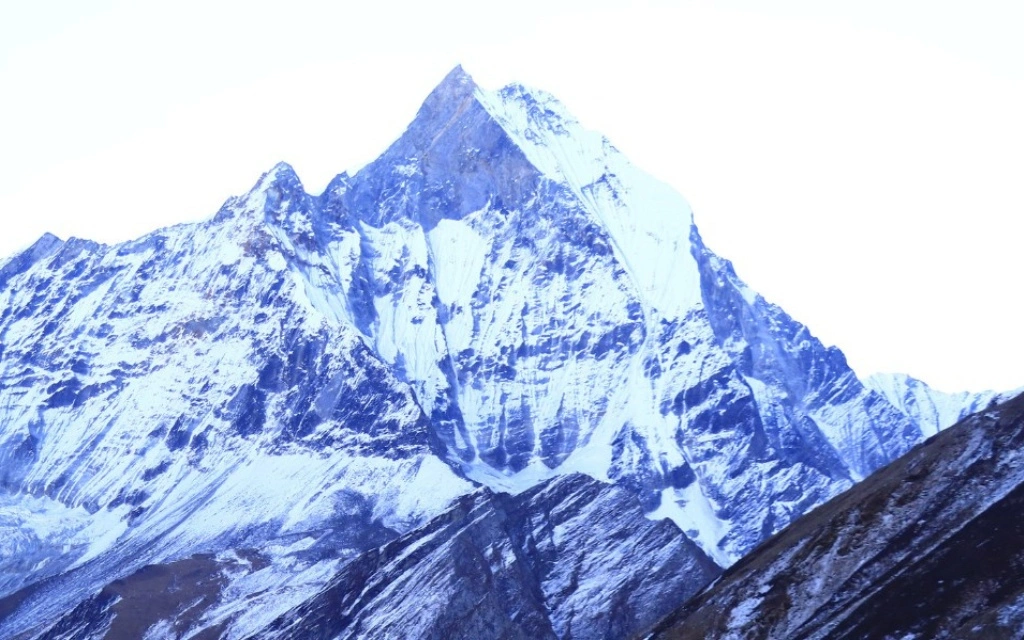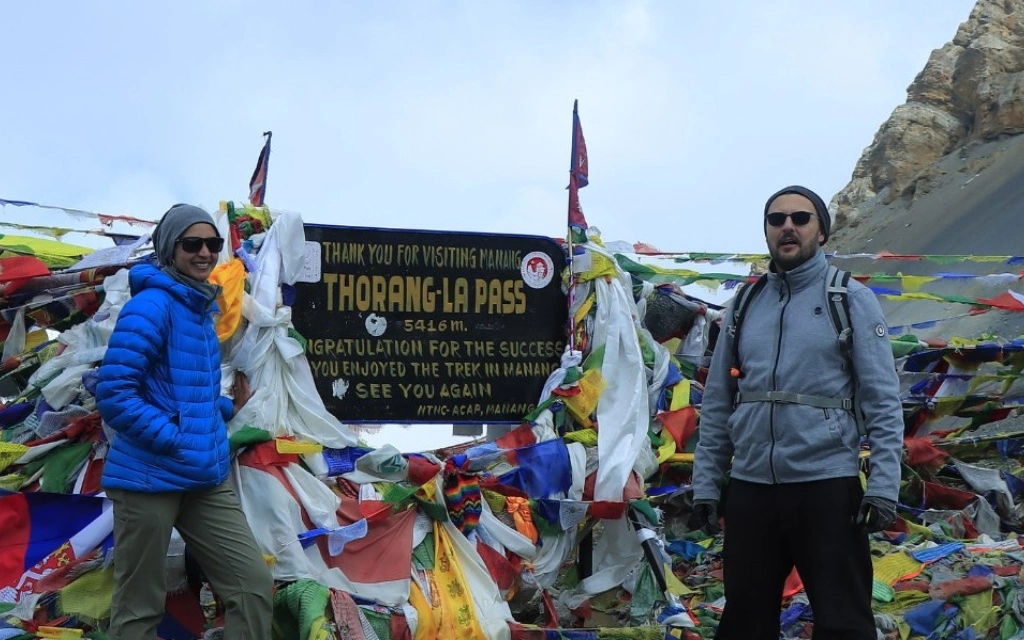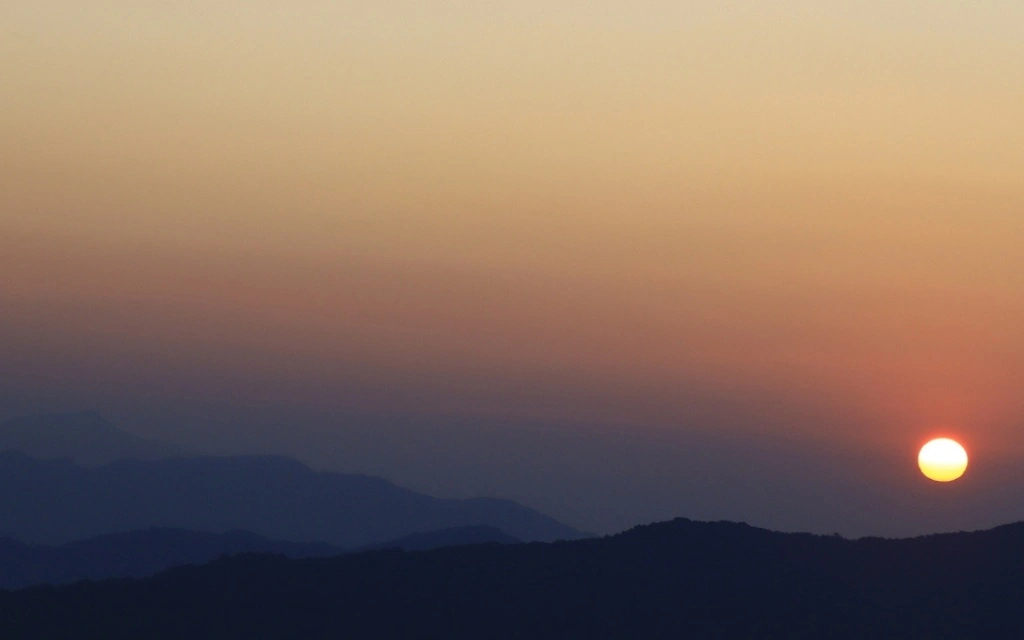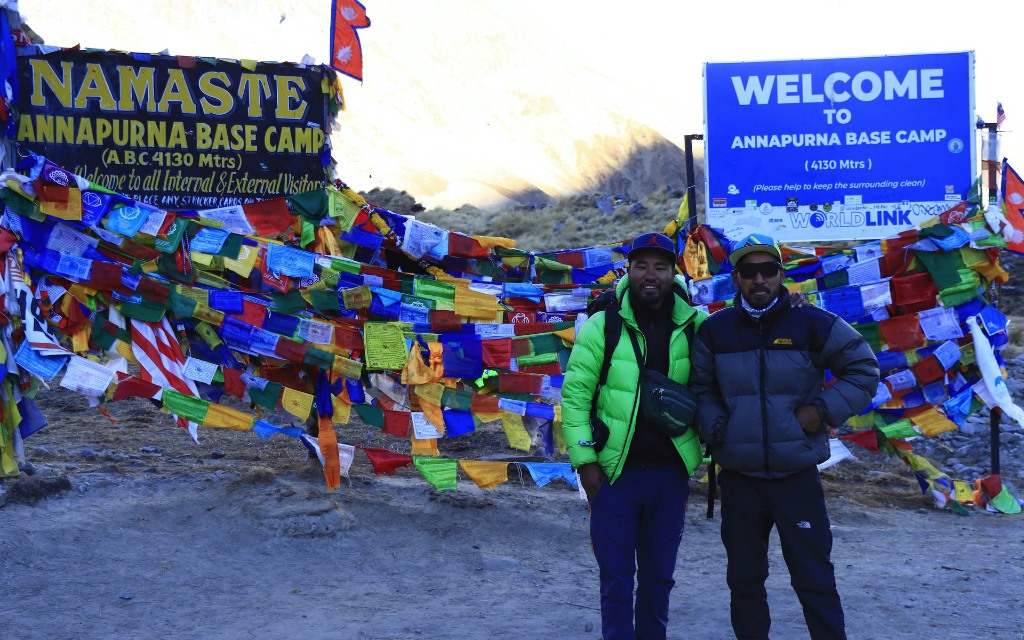
Annapurna Base Camp Trek 9 Days
Tour Gallery
Overview
Nestled within the heart of the magnificent Annapurna region, the Annapurna Base Camp Trek is a testament to the allure of the Himalayas and the spirit of adventure. This trekking odyssey, carefully weaving through the Annapurna Sanctuary, offers a captivating journey into a world of breathtaking landscapes, rich cultural encounters, and unparalleled mountain vistas.
Situated in north central Nepal, the Annapurna region is renowned for its diverse topography, featuring lush forests, terraced fields, and some of the world’s highest peaks. Among these, the Annapurna Base Camp Trek takes trekkers on an awe-inspiring ascent to the majestic Annapurna massif base camp, where panoramic views unfold like a Himalayan tapestry.
Geography and Location of the Annapurna Base Camp Trek
The Annapurna Base Camp Trek unfolds amidst the spectacular geography of the Annapurna region, a celebrated segment of the Nepalese Himalayas. This trekking haven is in the north-central part of Nepal, nestled between the Dhaulagiri and Manaslu mountain ranges.
A diverse and ever-changing landscape characterizes the trek’s geographical features. Commencing from the vibrant town of Pokhara, trekkers embark on a journey that spans terraced fields, rhododendron forests, and quaint villages before ascending into the high-altitude realm of the Annapurna Sanctuary. The Sanctuary, an amphitheater of colossal peaks, encompasses the base camp of the formidable Annapurna massif.
The Annapurna massif is home to several prominent peaks, including Annapurna I, the tenth-highest mountain globally, standing proudly at 26,545 feet (8,091 meters). Other notable peaks in the vicinity include Annapurna South, Machapuchare (also known as Fishtail), and Hiunchuli.
Cultural and Natural Highlights of the Annapurna Base Camp Trek
The Annapurna Base Camp Trek is a tapestry woven with cultural richness and natural wonders. As trekkers traverse through the diverse landscapes of the Annapurna region, they encounter a spectrum of cultural highlights and immerse themselves in the pristine beauty of the Himalayas.
Cultural Highlights:
- Gurung Villages: Trekking through charming Gurung villages like Chhomrong provides a glimpse into the traditional lifestyle of the indigenous people. The Gurung community is known for its warm hospitality and vibrant cultural practices.
- Local Festivals: Depending on the timing of the trek, trekkers may have the opportunity to witness or even participate in local festivals celebrated by the communities along the trail. These festivals offer insights into the rich cultural tapestry of the region.
- Teahouse Hospitality: Staying in teahouses along the trek allows trekkers to interact with locals, learn about their customs, and savor traditional Nepali cuisine. These interactions contribute to the cultural immersion that defines the Annapurna Base Camp Trek.
- Charming Monasteries: En route to the base camp, trekkers pass by and may visit ancient monasteries, such as those in Tadapani and Chhomrong. These monastic sites provide serene spaces for reflection and a chance to observe Buddhist rituals.
Natural Highlights:
- Rhododendron Forests: The trek offers a passage through lush rhododendron forests, particularly vibrant during spring when these flowering trees paint the landscape with red, pink, and white hues.
- Terraced Fields: The lower reaches of the trek feature terraced fields, a testament to the agricultural practices of the local communities. The patchwork of green fields against the backdrop of the Himalayas creates a picturesque setting.
- Hot Springs at Jhinu Danda: A cultural and natural treat, Jhinu Danda is renowned for its natural hot springs. Trekkers can rejuvenate their tired muscles in these thermal baths while surrounded by the scenic beauty of the Annapurna region.
- Panoramic Vistas: The trek offers numerous vantage points, including Poon Hill, providing breathtaking panoramic views of the Annapurna and Dhaulagiri mountain ranges. These vistas serve as rewards for the physical exertion of the trek.
- Annapurna Base Camp (ABC): Annapurna Base Camp is the pinnacle of natural beauty on the trek, a high-altitude sanctuary surrounded by towering peaks. The grandeur of the theater of mountains is a spectacle that leaves an indelible mark on trekkers.
Challenges and Considerations of the Annapurna Base Camp Trek
Embarking on the Annapurna Base Camp Trek is a thrilling adventure, but it comes with challenges and considerations that trekkers should consider. Understanding and preparing for these factors are crucial to ensuring a safe and enjoyable trekking experience.
High-Altitude Challenges
Acclimatization becomes vital to prevent altitude sickness as the trek ascends to higher altitudes. Trekkers should follow a gradual ascent, stay hydrated, and take necessary rest days to allow their bodies to adjust to the thinning air.
Recognizing the symptoms of altitude sickness, such as headaches, nausea, and dizziness, is crucial. Trekkers must communicate discomfort to their guides and consider descending if symptoms persist.
Weather Conditions
The Annapurna region experiences diverse weather conditions. Trekkers should be prepared for sudden changes in weather, including rain, snow, and cold temperatures. Carrying waterproof gear and dressing in layers is essential.
While the trek is possible throughout the year, the ideal seasons are pre-monsoon (spring) and post-monsoon (autumn) when the weather is relatively stable and the views are clear.
Physical Fitness Requirements
The trek involves challenging terrains, including steep ascents and descents. Trekkers should have a reasonable fitness level, engage in pre-trek training, and be prepared for long days of walking.
Carrying a backpack with essentials can be physically demanding. Trekkers should pack wisely, carrying only necessary items, and consider hiring a porter to ease the load.
Choosing Experienced Guides
Engaging experienced and certified trekking guides is crucial. Local guides are familiar with the terrain and weather conditions and can provide valuable insights into the region’s culture.
Panoramic Views and Landmarks on the Annapurna Base Camp Trek
The Annapurna Base Camp Trek is a visual symphony, offering trekkers an enchanting panorama of towering peaks, lush valleys, and awe-inspiring landscapes. Several vantage points and landmarks along the trail provide breathtaking views, creating lasting memories of the Himalayan journey.
- Poon Hill: Situated en route to Ghorepani, Poon Hill is a renowned viewpoint offering one of the most spectacular sunrise vistas in the Himalayas. Trekkers ascend early to witness the sun casting its golden glow on the Annapurna and Dhaulagiri mountain ranges.
- Tadapani Viewpoint: As trekkers travel from Ghorepani to Tadapani, they encounter viewpoints that provide stunning glimpses of the surrounding peaks, including Machapuchare and Annapurna South.
- Chhomrong Ridge: Chhomrong, a picturesque Gurung village, is perched on a ridge offering panoramic views of the Annapurna massif. Trekkers can savor these views while acclimatizing in this charming village.
- Bamboo Forests: The trek through lush bamboo forests provides a unique perspective, with sunlight filtering through the dense foliage and creating a magical atmosphere.
- Annapurna Base Camp (ABC): The ultimate destination, Annapurna Base Camp, sits amidst a natural amphitheater surrounded by towering peaks. Trekkers are rewarded with a 360-degree panorama that includes Annapurna I, Machapuchare, Hiunchuli, and other majestic summits.
Preparation and Packing Tips for the Annapurna Base Camp Trek
Embarking on the Annapurna Base Camp Trek requires thoughtful preparation and strategic packing to ensure a comfortable and enjoyable journey through the stunning landscapes of the Himalayas. Here are essential tips to help trekkers prepare for this adventure:
Physical Fitness:
Engage in cardiovascular exercises, strength training, and hiking to build endurance. Focus on activities that simulate the demands of trekking at high altitudes.
Acclimatization
Plan the trek itinerary to include incremental altitude gains, allowing the body to acclimatize effectively. Take rest days to aid acclimatization and reduce the risk of altitude sickness.
Proper Gear
Invest in comfortable, well-fitted, and waterproof hiking boots. Break them in before the trek to prevent blisters.
Pack layers to adapt to changing temperatures. Include moisture-wicking base layers, insulating mid-layers, and a waterproof outer shell.
Essential Clothing
Choose clothing made from quick-drying materials to manage sweat and moisture.
Protect yourself from the sun with a wide-brimmed hat and UV-blocking sunglasses..
Hydration and Nutrition
- Water Purification: Carry a water purification system to ensure a safe water supply.
- Snacks: Pack energy bars, trail mix, and other high-energy snacks to fuel your trek.
Documentation
Obtain the necessary trekking permits and have multiple copies of your passport and passport-sized photos.
We suggest you to carry a list of emergency contacts, including local rescue services and embassy information.
Trip Highlights
- Annapurna means “full of food,” significant to Hindus as the “Goddess of Harvest.
- Annapurna-I is the tenth-highest mountain in the world at 8,091 meters.
- Annapurna was the first eight thousandar ever to be climbed in 1950.
- The renowned Tilicho Lake lies in the Annapurna Region.
- The successful climbing ratio of Annapurna is only 38%, making it the most dangerous 8000ar to climb.
What's Included
Included Services
- ✓Airport pickup and drop services in a private vehicle
- ✓Transportation from Kathmandu to Pokhara and back to Kathmandu in tourist bus (optional flight with extra costs)
- ✓Food all along the trip (Breakfast, Lunch, Dinner and a cup of coffee or tea) and accommodations during the trip in hotels with family environment (including two nights stay in Pokhara)
- ✓Licensed English speaking trekking guide
- ✓Transportation, food, accommodation and insurance of guide and porter during the trip
- ✓First Aid Medical Kit carried by the guide
- ✓All the required permits and paperworks
- ✓Mobile SIM Card that works all over Nepal and a map of the trekking region
- ✓Complimentary welcome or farewell dinner in Kathmandu at a cultural restaurant
Excluded Services
- ✗International airfare
- ✗Visa charges
- ✗Your travel and medical insurance
- ✗Personal expenses such as shopping, bar bills, hot shower, telephone, laundry, titbits etc
- ✗Food and accommodation in Kathmandu
- ✗Emergency expenses such as expenses on charted helicoptor
- ✗Tips for guides and porters
Detailed Itinerary
More Information
How difficult is Annapurna Base Camp trek?
The Annapurna Base Camp trek is moderate in difficulty and suitable for trekkers with essential fitness. While challenging ascents and descents exist, gradual acclimatization, proper preparation, and support from experienced guides make it accessible to many enthusiasts.
How long is the hike to Annapurna Base Camp?
The trek to Annapurna Base Camp typically takes around 10 to 14 days, covering approximately 115 kilometers (71 miles) round trip. The duration can vary based on the route, weather conditions, and the trekker’s pace.
Are there any permits required for this trek and how can I obtain them?
A TIMS (Trekkers’ Information Management System) card and an Annapurna Conservation Area Permit (ACAP) are required for the Annapurna Base Camp Trek. These permits can be obtained in Kathmandu or Pokhara through National Tourism Board.
Is it safe to trek Annapurna Base Camp?
Yes, trekking to Annapurna Base Camp is generally considered safe. However, trekkers should follow safety guidelines, acclimatize properly, hire experienced guides, and be prepared for changing weather conditions. Emergency evacuation services are available if needed.
How much does it cost to trek at Annapurna Base Camp?
These 9 days of trek is not that expensive when compared with other trekking destinations in Nepal. As you will enter the Annapurna Conservation area, a permit is required. These permits and TIMS( Trekkers Information Management System) will be provided by your trekking provider. This average duration of the trek will cost you around 700 USD and 1000 USD, depending on your itinerary. Thus, you can trek this land with Nepal Lion treks at 650 USD.
Is Annapurna Base Camp harder than Everest?
Annapurna Base Camp is more accessible than Everest Base Camp in terms of trekking difficulty. Everest Base Camp involves higher altitudes and more strenuous conditions. Annapurna Base Camp is a moderate trek, making it more accessible for a broader range of trekkers.
Is there Internet in Annapurna Base Camp?
Exactly at the base camp, you won’t get internet access. But throughout the trails, and tea houses you will get good connections. Some Lodges and teahouses even provide free Wi-Fi. Whereas typically, these teahouses charge you USD 1- USD4 for internet service and charging.
Can a beginner climb Annapurna?
Annapurna is not recommended for beginners to climb. While the trek to Annapurna Base Camp is feasible for beginners with proper preparation, climbing the actual peak is an advanced mountaineering endeavor requiring technical skills and experience.
Is Annapurna deadlier than Everest?
Annapurna has a higher fatality rate among climbers compared to Everest, earning it the nickname “the deadliest peak.” The challenging conditions, avalanches, and technical difficulties contribute to the heightened risk associated with Annapurna.
Can you climb Annapurna without oxygen?
Climbing Annapurna without supplemental oxygen is a highly challenging and risky endeavor. The high altitudes and harsh conditions make it one of the most challenging peaks to climb without oxygen, requiring exceptional mountaineering skills and experience.
